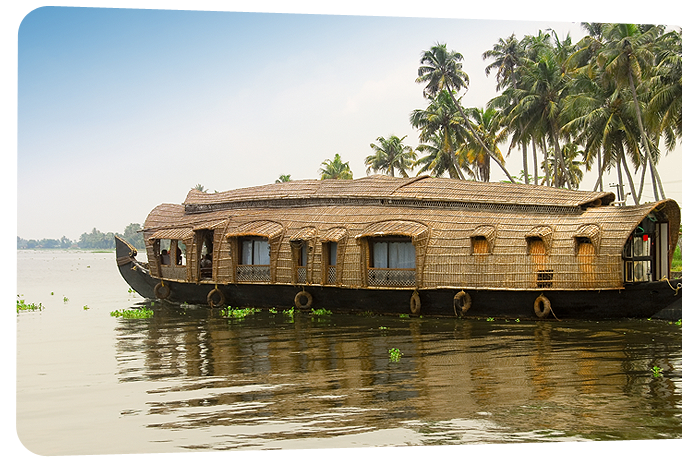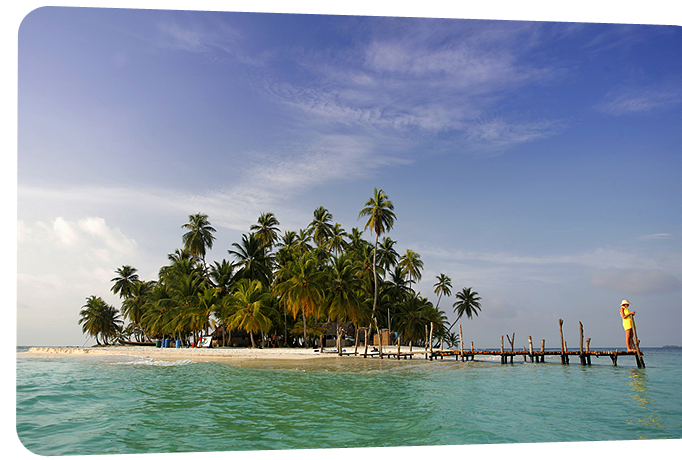| Day 06 |
Kumbakonam / Tanjore /Kumbakonam |
(40 Kms, 01 Hr each way) |
Morning buffet breakfast at the hotel
After breakfast drive to Tanjore (40 Kms, 01 Hr)

Tanjore is known as the "rice bowl" of Tamil Nadu. It is also a center of craftsmanship noted especially for its silks and bronze ware and is a leading South Indian music and dance center. Among the city's many Hindu temples, the most famous is the Brihadishwara temple, one of the greatest examples of Dravidian architecture, which dates to the 11th century, when Tanjore was capital of the Hindu Chola kingdom and passed under British rule in 1799.
Upon arrival visit -
Brihadishwara temple – built by Raja Raja in 1010, it is the crowning glory of Chola temple architecture and the highlight of Thanjavur. Known locally as ‘Big Temple’, this fascinating monument is one of only a handful in India with world heritage listing and is worth a visit.
Royal Palace - A massive structure with huge halls, wide corridors, observation towers and a shady courtyard. As you walk across, you can easily see many sections of the palace in ruins and also the restoration work that has been taken up to protect the monument. The palace is home to a library, an art gallery and a museum.
Royal museum - A display of items from the past rulers. The royal memorabilia is a real eye catcher and fascinates one and all. The royal clothing, headgears and hunting weapons are some of such items that draw the attention of visitors. The two Durbar halls, where the rulers held public meetings, are in good shape.
Art Gallery - This gallery has a superb collection of artifacts of the 8th and 9th century, belonging to the Chola dynasty. The bronze and granite statues displayed inside the art gallery speak volumes about the craftsmanship during those days. The bell tower, which has been restored, stands very different from the rest of the structure after renovation.
Saraswathi Mahal Library - Stands next to the art gallery. This library has an amazing collection of manuscripts written on palm leaves and paper. There are over 44,000 palm leaf and paper manuscripts in Indian and European languages inside the Saraswati Mahal library. Of all the manuscripts, over eighty percent are in Sanskrit. The Tamil work, at display in the library, includes treatises on medicine and commentaries on works belonging to the Sangam period.
Late evening Drive back to Chidambaram
Overnight stay at Hotel
| Day 07 |
Tanjore / Trichy / Madurai by surface |
(200 Kms, 04 Hrs) |
Morning buffet breakfast at the hotel
After breakfast drive to Trichy (55 Kms, 01 Hr)
Trichy is a sprawling but extremely enjoyable city. It is situated on the banks of the river Cauvery and is the fourth largest city in Tamil Nadu. It was a citadel of the early Cholas which later fell to the Pallavas. Trichy is a fine blend of tradition and modernity built around the Rock Fort.
In Trichy visit –
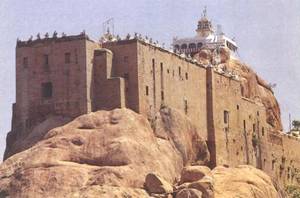 Rock Fort Temple - The 83m high Rock Fort is the only outcrop in the otherwise flat land of the city. The rock is one of the oldest in the world-approximately 3.800 million years, which makes it as old as the rocks of Greenland and older than the Himalayas. The sheer abruptness of its rise is a thrill in itself, but the actual centre of attraction is not the fort itself, of which very little remains, but the temple at the summit. 344 steps hewn out of rock lead to the top where there are inscriptions dating back to the 3rd century B.C. Hardly anything remains of the ramparts but the Main Guard Gate is still intact. The fort played an important part during the Carnatic wars and according to an inscription, mainly contributed to lay the foundations of the British Empire in India. Rock Fort Temple - The 83m high Rock Fort is the only outcrop in the otherwise flat land of the city. The rock is one of the oldest in the world-approximately 3.800 million years, which makes it as old as the rocks of Greenland and older than the Himalayas. The sheer abruptness of its rise is a thrill in itself, but the actual centre of attraction is not the fort itself, of which very little remains, but the temple at the summit. 344 steps hewn out of rock lead to the top where there are inscriptions dating back to the 3rd century B.C. Hardly anything remains of the ramparts but the Main Guard Gate is still intact. The fort played an important part during the Carnatic wars and according to an inscription, mainly contributed to lay the foundations of the British Empire in India.
Srirangam – It is beautiful island surrounded by river Cauvery and Kollidam (tributary of Cauvery). Srirangam is 8 miles in length and 4 miles in breadth. Srirangam is a holy place. Importantly for vaishnavaite, because, their God Vishnu is in the name of “Renganathar” in a sleeping posture (called Anantha sayanam), which could not be seen any where else like this.
Lunch at a hotel in Trichy [direct payment ]
After lunch drive to Madurai (145 Kms, 03 Hrs)
The temple town of South India was once the capital of the Pandya rulers, it has been built in the shape of a lotus and it is said that it was named 'Madhurapuri' as Lord Shiva showered divine nectar here on the day it was to be named. Later, the name distorted to Madurai. World renowned Meenakshi temple has become an icon of the city. The city is famous for its jasmine flowers.
Upon arrival check-in at hotel
Overnight stay at Hotel
Morning buffet breakfast at the hotel
After breakfast visit –
 Meenakshi Temple - located at the heart of the city; the Meenakshi-Sundareswarar temple has long been the focus of both Indian and international tourist attraction as well as one of the most important places of Hindu pilgrimage. It is the hub of the religious and cultural life of the city. Kulasekara Pandya built this pre- Christian era temple. However, it was in ruins before Tirumalai Nayak who brought back the glory to this magnificent structure rebuilt it. Entry of foreigners is restricted in the inner sanctum. Meenakshi Temple - located at the heart of the city; the Meenakshi-Sundareswarar temple has long been the focus of both Indian and international tourist attraction as well as one of the most important places of Hindu pilgrimage. It is the hub of the religious and cultural life of the city. Kulasekara Pandya built this pre- Christian era temple. However, it was in ruins before Tirumalai Nayak who brought back the glory to this magnificent structure rebuilt it. Entry of foreigners is restricted in the inner sanctum.
Tirumala Nayak Palace - an example of architectural grandeur and was built by King Thirumalai Nayak in 1636 AD. The palace was designed by an Italian Architect and served as the residence of the King.
Evening attend pooja (prayer) ceremony at Meenakshi Temple
Overnight stay at Hotel
| Day 09 |
Madurai / Periyar by surface |
(160 Kms, 04 Hrs) |
Morning buffet breakfast at the hotel
After breakfast you will be driven to Periyar (160 Kms, 04 Hrs)
The drive to Thekkady is enchanting as the road winds through tranquil countryside, rich plantations & thick jungles. Thekkady (Idukki district) is the location of the Periyar National Park,
across 777 km² (300 sq. miles), of which 360 km² (139 sq. miles) is thick evergreen forest. This Wild Life Sanctuary was declared a Tiger Reserve in 1978.
The splendid artificial lake formed by the Mulla Periyar Dam across the Periyar River adds to the charm of the park. The greatest attraction of Periyar is the herds of wild elephants that come down to play in the lake. Thekkady is also considered a heaven for natural spices such as black pepper, cardamom, cinnamon and clove.
On arrival, you will check-in at your hotel.
In the afternoon, you are at leisure.
Optional: The Periyar Lake lies at the heart of the sanctuary, which is a veritable paradise for all wildlife lovers. Situated within the boundaries of the Western Ghats in the southern Indian state of Kerala, Periyar National Park and Tiger Reserve is one of the most captivating wildlife parks in the world. Periyar Wildlife Sanctuary was declared a Project Tiger reserve in 1978. Its unique ecosystem which consists of thick moist deciduous vegetation, dense evergreen forests and the aquatic environment of the Periyar Lake make Periyar a unique and precious wildlife resource.
The animals you can see in Periyar Wildlife sanctuary are tigers, though they remain concealed in the dense jungle and elephants, which can be seen in herds and family groups along the banks of Periyar Lake. The interaction between the elephants in a herd and their behavior while they drink, bathe and engage in mock fights and play on the lake's edge is a fascinating sight. A boat cruise on Periyar Lake is a good way to observe the elephants from a short distance away, without disturbing them.
Overnight at the hotel
Breakfast is at the Hotel.
After breakfast, you will be taken for a guided walk in the spice plantation.
The spice plantation in Thekkady is a prime attraction of this beautiful land. Though sprawling tea estates cover much of the landscape of Thekkady, plantations of cardamom, rubber, vanilla and coffee are also aplenty. Walk amidst the green, terraced farms of the various spices and breathe in the fragrant air while exploring the spice plantations. Pick up a few packets of the tea and spices grown here that make for a good buy. There are various kinds of spices cultivated in Thekkady. The most abundantly found spice in Thekkady is pepper. But there is a variety of cinnamon, clove, nutmeg, ginger, turmeric and curry leaves on the slanting slopes of the spice plantation in Thekkady.
Afternoon proceed for an elephant ride in the spice plantations and later you are free to explore Kumily town
| Day 11 |
Periyar /Kumarakom by surface |
(180 Kms, 04 Hrs) |
Morning buffet breakfast at the hotel
After breakfast check-out from the hotel and drive to Kumarakom
Kumarakom lies on the banks of the famous Vembanad Lake. The Kumarakom Bird Sanctuary, an ornithologist's paradise is a favorite haunt of migratory birds like the Siberian stork, egret, darter, heron and teal is just across the lake from the hotel.
The day is free at leisure
Overnight at the hotel
| Day 12 |
Kumarakom /House boat |
|
Morning buffet breakfast at the hotel
By noon, check out from the hotel and board the house boat (locally known as Kettuvallams)
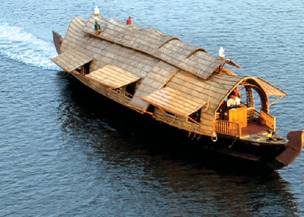 Kettuvallams, the stitched boats provide the best way to experience the colourful backwaters of Kerala. The wood commonly used to make Kettuvallams is 'Anhili', which is found in abundance in central Travancore area. Large planks are tied together using hand made coir ropes and beaten coconut fibres. This gives the Kettuvallams enough strength to withstand heavy waves in the sea. Kettuvallams are built entirely without the use of nails. It requires great skill and adroitness to construct these giant boats by tying huge planks of jack wood together. The boats are applied with fish oil and cashew nut oil and left to cure for days. With careful maintenance, they last for generations. Kettuvallams, the stitched boats provide the best way to experience the colourful backwaters of Kerala. The wood commonly used to make Kettuvallams is 'Anhili', which is found in abundance in central Travancore area. Large planks are tied together using hand made coir ropes and beaten coconut fibres. This gives the Kettuvallams enough strength to withstand heavy waves in the sea. Kettuvallams are built entirely without the use of nails. It requires great skill and adroitness to construct these giant boats by tying huge planks of jack wood together. The boats are applied with fish oil and cashew nut oil and left to cure for days. With careful maintenance, they last for generations.
Overnight on board the houseboat
| Day 13 |
Alleppey / Cochin by surface |
(60 Kms, 01 Hr) |
Morning breakfast at the houseboat
After breakfast disembark from houseboat and drive to Cochin (60 Kms, 01 Hr)
Cochin is a vibrant city situated on the south-west coast of the Indian peninsula in the breathtakingly scenic and prosperous state of Kerala, hailed as 'God's Own Country'. Its strategic importance over the centuries is underlined by the sobriquet Queen of the Arabian Sea. Informally, Cochin is also referred to as the Gateway to Kerala.
Upon arrival check-in at hotel
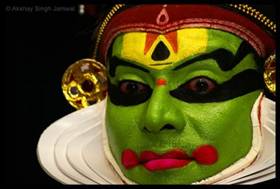 In the evening, you will enjoy Kathakali dance performance. Kathakali is the classical dance-drama of Kerala, South India, which dates from the 17th century and is rooted in Hindu mythology. The dance has a unique combination of literature, music, painting, acting and dance. It draws heavily from drama and is danced with elaborate masks and costumes. Kathakali recitals are generally long and while other dance forms are more emotive than narrative, Kathakali is both. It combines dance with dialogue to bring myth and legend to life in the temple courtyards of Kerala. The dancers use their stunning costumes and make-up, with the accompaniment of drums and vocalists, to create various moods and emotions. In the evening, you will enjoy Kathakali dance performance. Kathakali is the classical dance-drama of Kerala, South India, which dates from the 17th century and is rooted in Hindu mythology. The dance has a unique combination of literature, music, painting, acting and dance. It draws heavily from drama and is danced with elaborate masks and costumes. Kathakali recitals are generally long and while other dance forms are more emotive than narrative, Kathakali is both. It combines dance with dialogue to bring myth and legend to life in the temple courtyards of Kerala. The dancers use their stunning costumes and make-up, with the accompaniment of drums and vocalists, to create various moods and emotions.
Overnight stay at the Hotel
Morning sightseeing of the town
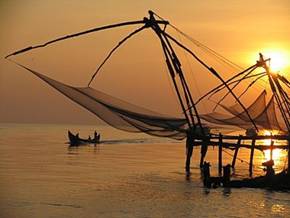 All the sightseeing places are located in the Fort Cochin (Jew Town) area itself. Begin with Dutch Palace also known as Mattancherry Palace. It was built by the Portuguese and presented to the Raja of Kochi in 1555 AD. It acquired the present name after 1663 when the Dutch carried out extensions and repairs in the palace. At no time did the Portuguese or Dutch stay here. Its interiors are decorated with murals from the Ramayana and there are some lively displays of royal costumes and palanquins. [Closed on Fridays] Then visit Jewish Synagogue built in 1568 AD. The Great Scrolls of the Old were recorded and the exquisite Chinese hand-painted tiles are of interest here. [Closed on Friday & Saturday] You will also visit St. Francis Church in Fort Kochi. The Protestant church was originally built by the Portuguese in 1510 AD and is believed to be the oldest church built by the Europeans in India. It is here the remains of the inveterate traveller, Vasco-da-Gama were initially buried and 14 years later, his mortal remains were taken to Portugal. Santa Cruz Basilica Church is also worth visiting. Some beautiful paintings can be seen here. All the sightseeing places are located in the Fort Cochin (Jew Town) area itself. Begin with Dutch Palace also known as Mattancherry Palace. It was built by the Portuguese and presented to the Raja of Kochi in 1555 AD. It acquired the present name after 1663 when the Dutch carried out extensions and repairs in the palace. At no time did the Portuguese or Dutch stay here. Its interiors are decorated with murals from the Ramayana and there are some lively displays of royal costumes and palanquins. [Closed on Fridays] Then visit Jewish Synagogue built in 1568 AD. The Great Scrolls of the Old were recorded and the exquisite Chinese hand-painted tiles are of interest here. [Closed on Friday & Saturday] You will also visit St. Francis Church in Fort Kochi. The Protestant church was originally built by the Portuguese in 1510 AD and is believed to be the oldest church built by the Europeans in India. It is here the remains of the inveterate traveller, Vasco-da-Gama were initially buried and 14 years later, his mortal remains were taken to Portugal. Santa Cruz Basilica Church is also worth visiting. Some beautiful paintings can be seen here.
Finally visit Chinese Fishing Nets - The cantilevered fishing nets line the entrance to the harbour mouth. Chinese traders are believed to have originally introduced them in the 14th century although, today parts of the nets are known by Portuguese names.
Overnight stay at the Hotel
| Day 15 |
Cochin - Departure |
|
After breakfast, check out from the hotel and you are transferred to Cochin airport
END OF TOUR SERVICES |

